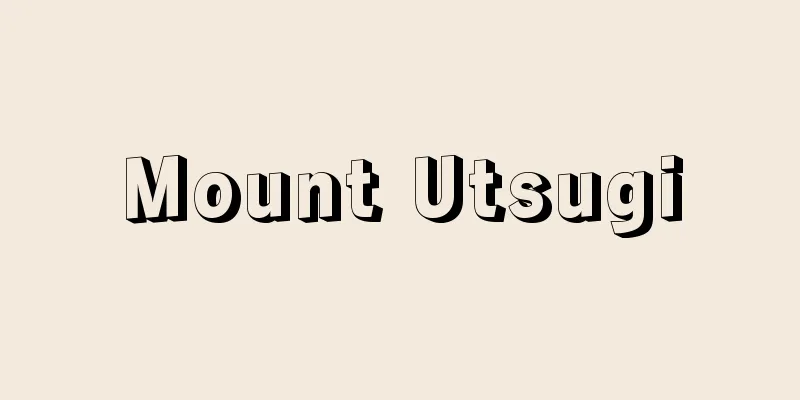Nursery Rhymes - Nursery Rhymes

|
A general term for "children's songs." However, it is more common to refer only to songs created by modern composers, excluding "warabeuta (children's songs)" that have been handed down through the generations. The term "children's song" is used in the Nihon Shoki and other books, following the example of the Chinese "Han Shu" and "Gokan Shu." However, unlike in China, it does not necessarily refer to songs sung by children. As the reading of the Japanese reading "wazauta" suggests, it vaguely refers to songs that are a kind of voice of social criticism expressed through the mouth of a child who is considered a divine being. There are several examples of satirical or incantatory songs that can be considered a genre of folk song among various ethnic groups, such as "Mother Goose songs" in England and children's festival songs in Micronesia. In many cases, the superficial meaning of the lyrics is designed to attract children's interest, but the deep ambiguity of folk beliefs hidden behind them is designed to be understood only by adults. In the narrow sense, children's songs are so-called "original children's songs" created by writers and composers motivated by educational considerations, as is typically seen in modern Japan. In Europe, examples include "Tie and Open," said to be the work of J. J. Rousseau, and a series of works by Orff. In Japan, a number of songs created as part of the children's song movement that began in the Taisho period as a reaction against the school songs that had been used since the Meiji period became widely circulated. These songs do not necessarily contain elements of traditional children's songs, but are thought to have expressed the trends of the times with their fresh lyrics and familiar melodies. For example, works created by collaborations between lyricists such as Suzuki Miekichi, Kitahara Hakushu, Saijo Yaso, Miki Rofu, and Noguchi Ujo and composers such as Narita Tamezo, Yamada Kosaku, Hirota Ryutaro, Fujii Kiyomi, and Nakayama Shinpei are still widely known today. The rise and prosperity of the recording industry was instrumental in the popularization of children's songs of this period. After the Second World War, the situation changed with the new transmission route via the mass media. Following the revival of children's songs for young children, represented by the "singing ladies" on the radio, Nakata Yoshinao, Dan Ikuma, Onaka Megumi, and Akutagawa Yasushi composed songs that made better use of the characteristics of the Japanese language than ever before. From the 1960s, as television became more widespread, songs became even more diverse. The current situation is that songs that are difficult to distinguish stylistically from commercial songs and pop songs are being produced, such as rhythmic songs that are linked to physical exercises, such as "Ping Pong Pan Exercise," theme songs and anime songs that are linked to visual images, and songs that are difficult to distinguish stylistically from commercial songs and pop songs. In any case, the history of children's songs can be traced back to a trend away from adults creating songs for children and toward songs that are closer to the real lives of children. [Osamu Yamaguchi] "Japanese Children's Songs" edited by Yoda Junichi (Iwanami Bunko) "The Hometown of Children's Songs" by Kami Shoichiro (1975, Rironsha) [References] |Source: Shogakukan Encyclopedia Nipponica About Encyclopedia Nipponica Information | Legend |
|
「子供の歌」の総称。ただし、民間で伝承されてきた「わらべうた(童唄)」を除外して、近代の作曲家により創作されたものだけをさすことのほうが多い。「童謡」という語は、中国の『漢書(かんじょ)』『後漢書(ごかんじょ)』に倣って『日本書紀』などに用例がみられるが、中国の場合と違って、かならずしも子供が歌うものとは限らず、「わざうた」と訓読みしていたことからもわかるように、神的な存在としての子供の口を介して表現される社会批判の声に類する歌を漠然とさしていた。民謡の一ジャンルともみなせるこうした風刺歌ないし呪術(じゅじゅつ)歌は、イギリスの「マザー・グースの歌」、ミクロネシアの児童祭礼歌など、諸民族にいくつか例がある。それらは多くの場合、歌詞の表面上の意味は子供の興味をひくようにできていても、その背後に隠された民間信仰上の深い多義性は大人にしかわからないようにできている。 狭義の童謡は、近代日本で典型的にみられるように、教育的配慮に動機づけられた文学者と作曲家によるいわゆる「創作童謡」である。ヨーロッパでは、J・J・ルソー作といわれる『結んで開いて』やオルフの一連の作品がある。日本では、明治以来の学校唱歌に反発する形で大正期に始まった童謡運動によりつくりだされた歌の数々が一般に流布するようになる。これらは、かならずしも伝統的な童唄の要素を備えてはいず、むしろ新鮮な作詞と親しみやすい旋律で時代の思潮を表明したと考えられている。たとえば、鈴木三重吉(みえきち)、北原白秋(はくしゅう)、西条八十(やそ)、三木露風(みきろふう)、野口雨情(うじょう)らの作詞家と、成田為三(ためぞう)、山田耕筰(こうさく)、弘田(ひろた)竜太郎、藤井清水(きよみ)、中山晋平(しんぺい)らの作曲家との連携による作品が現在でも広く知られている。この時期の童謡の普及に役だったのはレコード産業の勃興(ぼっこう)と隆盛であった。 第二次世界大戦後は、マス・メディアにのった新しい伝承経路により様相が変わる。ラジオの「歌のおばさん」を代表とする幼児向けの童謡復興運動にのって、中田喜直(よしなお)・團伊玖磨(だんいくま)・大中恩(めぐみ)・芥川也寸志(あくたがわやすし)らが日本語の特徴を以前にも増して生かした形で作曲した。1960年代からは、テレビが普及するにつれさらに多様化していく。「ピンポンパン体操」のように身体運動と結び付けたリズミカルな歌や、視覚的なイメージと連関させた主題歌やアニメ・ソング、さらにコマーシャル・ソングやポップスなどとの様式的区別がむずかしいものなどが輩出しているのが現状である。いずれにしても、子供のために大人がかってに創作する態度から、もっと子供の現実の生活に密着したものに近づけようとする傾向を童謡の歴史にたどることができる。 [山口 修] 『与田凖一編『日本童謡集』(岩波文庫)』▽『上笙一郎著『童謡のふるさと』(1975・理論社)』 [参照項目] |出典 小学館 日本大百科全書(ニッポニカ)日本大百科全書(ニッポニカ)について 情報 | 凡例 |
<<: Eastern medicine - Touyouigaku (English spelling) Eastern medicine
Recommend
Kanao - Ano
This is a former village area in the west of Gojo ...
Hierarchical method
...Traditional classification in biology was limi...
Pyroelectricity
Also known as pyroelectricity or pyroelectricity. ...
Ausonius, Decimus Magnus
[Raw] 310 approx. Bordeaux [Died] c. 393 A poet fr...
《Statue of the Barbarians (■1)》
…He is one of the painters who symbolizes the ris...
Azumanezasa (Higashine bamboo) - Azumanezasa (English name) Pleioblastus chino
A small bamboo of the Poaceae family. It is common...
Vendée Rebellion - The Vendée Rebellion
The largest counter-revolutionary peasant revolt d...
Hollow concrete block
...A product made by molding and hardening concre...
One-act play
A type of drama that is performed without an inter...
Colicroot
...It is distributed in Honshu (west of Kanto), S...
Oleandra pistillaris (English spelling) Oleandrapistillaris
…[Masahiro Kato]. . . *Some of the terminology th...
Feathers - Umo
A substance that grows on the surface of the body...
Garlic (Hul) - Garlic (English spelling)
A perennial plant of the lily family (illustration...
Isagi - Isagi
…A marine fish of the family Perciformes, family ...
Worms Agreement (English: Wormser Konkordat) German
An agreement concluded in 1122 between Holy Roman...









